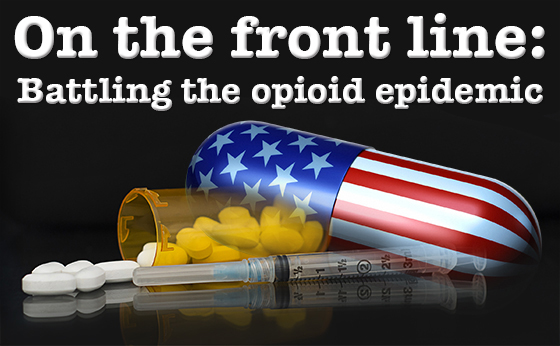|
March – April 2019
A roundup of recent news and information
 Provider directories identify physicians offering medication-assisted treatment
Provider directories identify physicians offering medication-assisted treatment
Practitioners who participate with Blue Cross Blue Shield of Michigan or Blue Care Network and who offer medication-assisted treatment for patients with substance abuse disorder will be identified in our Find a Doctor search feature on bcbsm.com. From the homepage of Find a Doctor, in the Search for doctors, hospitals and clinics by name or specialty field, members can enter Suboxone Treatment for Opiate Addiction to locate providers who are eligible to prescribe medication containing buprenorphine. For more information on medication-assisted treatment, see the column by Dr. Amy McKenzie in the November – December 2018 issue of Hospital and Physician Update.
Foundation grant helps pregnant mothers fight addiction
The Blue Cross Blue Shield of Michigan Foundation provided grant funding support for a program that helps expectant mothers who are battling substance use disorder. The GREAT MOMS program, which stands for Grand Rapids Encompassing Addiction Treatment with Maternal Obstetric Management, offers support to pregnant women by helping them navigate their prenatal appointments and get medication to treat substance use disorder. So far, 25 babies have been born to women who have successfully gone through the program. For more details, see the MI Blues Perspectives blog.
Opioid prescribing recommendations for surgery updated
The Michigan Opioid Prescribing Engagement Network, commonly referred to as M-OPEN, has updated its opioid prescribing recommendations* for specific surgical procedures. M-OPEN originally developed its recommendations based on patient-reported data from the Michigan Surgical Quality Collaborative and published studies. According to M-OPEN, studies have shown that when patients are prescribed fewer pills, they consume fewer pills with no changes in pain or satisfaction scores. Recommendations are for patients with no preoperative opioid use.
About 30 percent of opioid deaths may be suicides
An article published in The New England Journal of Medicine* last year estimated that as many as 30 percent of opioid overdoses may be suicides rather than unintentional deaths. According to the article, which analyzed Centers for Disease Control and Prevention data from 2000 to 2017, about 10 percent of suicides were from intentional overdose. And of those, a third involved opioids. In that period, deaths from suicide rose 60 percent, from 29,319 to 47,173, and the opioid-related suicide rate nearly doubled. In 2017, 1,887 Americans died of reported intentional opioid overdoses.
New analysis reveals magnitude of opioid epidemic
An examination of nearly two decades of drug overdose deaths shows that shifts in the year-to-year death toll, marked by relatively predictable peaks and valleys, mask the true magnitude of the opioid epidemic in America. The epidemic appears mired in a deadly new normal* for years to come, according to a U.S. News & World Report* analysis. The analysis states: Trends that seem apparent in hindsight escaped notice for years, with the failure to recognize a climb in deaths at the turn of the millennium — along with a subsequent slowdown — raising a compelling question: Did policymakers, law enforcement and public health officials miss chances to curb the opioid epidemic before it became a full-blown emergency?
Pain management task force outlines gaps in treatment of chronic pain
In December, the U.S. Department of Health and Human Services’ Pain Management Interagency Task Force released a draft report* outlining current gaps and preliminary recommendations for the treatment of acute and chronic pain. Following a 90-day comment period, the report will be finalized and submitted to Congress later this year. The task force was established by the Comprehensive Addiction and Recovery Act of 2016 and is tasked with determining whether gaps in or inconsistencies between best practices for acute and chronic pain management exist and to present updates and recommendations.
Data shows rural patients much more likely to receive an opioid prescription
A Morbidity and Mortality Weekly Report from the Centers for Disease and Control and Prevention in January 2019 addressed opioid use in rural, non-metropolitan counties. Researchers tracked opioid prescribing rates in counties across the country over a three-year period, from 2014 to 2017. The review found that over that time, general prescribing of prescription opioids fell while rates in rural, non-metropolitan counties declined at a slower rate. In the years following the implementation of the CDC’s chronic pain opioid prescribing guidelines,* the data demonstrated that rural patients were 87 percent more likely to receive an opioid prescription as compared to metropolitan patients.
Blue Cross, community partners take another step to address opioid epidemic
Blue Cross Blue Shield of Michigan is contributing to the Michigan Opioid Partnership, which will distribute a combined $2.6 million in grants to focus efforts on beginning medication assisted treatment in hospitals and emergency rooms, and improving transitions to outpatient care. Providing medication assisted treatment during hospital stays and emergency room visits has been shown to reduce the number of opioid-related deaths in the communities where it’s used. This partnership is a component of Blue Cross’ intense multipronged strategy to combat the opioid epidemic.
*Blue Cross Blue Shield of Michigan doesn’t own or control this website.
|






 Provider directories identify physicians offering medication-assisted treatment
Provider directories identify physicians offering medication-assisted treatment